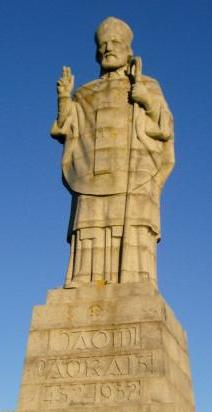| |
|
|
In 431, Pope
Celestine sent Palladius as first bishop to the Irish, Pallidus
died shortly after arriving in Ireland. He was replaced by Patrick
who landed in Ireland in 432, he become the patron saint of
Ireland. Patrick was a native of  Britain,
the son of a wealthy official. When he was about 16 years of age,
he was captured by Irish raiders (probably acting under the orders
of the Irish king Niall Noigiallach 'Niall of the Nine Hostages')
.And taken as a slave to Ireland. For six years, he herded sheep
for his Irish master, it is said on Slemish mountain County Antrim.
He escaped, legend is that he stowed away on a ship bound for England,
loaded with Irish Wolfhounds. From England he went to France and
studied under Saint Germanus. There he became a bishop and returned
to Ireland with the intention of converting the pagan Irish to Christianity. Britain,
the son of a wealthy official. When he was about 16 years of age,
he was captured by Irish raiders (probably acting under the orders
of the Irish king Niall Noigiallach 'Niall of the Nine Hostages')
.And taken as a slave to Ireland. For six years, he herded sheep
for his Irish master, it is said on Slemish mountain County Antrim.
He escaped, legend is that he stowed away on a ship bound for England,
loaded with Irish Wolfhounds. From England he went to France and
studied under Saint Germanus. There he became a bishop and returned
to Ireland with the intention of converting the pagan Irish to Christianity.
According to tradition in 432, Patrick landed
at the mouth of the Slaney river which flows into Strangford
Lough near Saul, in County Down, he made contact with the local
chieftain Diohu who after a conversation with Patrick gave him his
barn the Irish word for barn was sabhall, Patrick converted it and
so it became his first
church in Ireland. He was called before the high king, Laoghaire,
at Tara, Laoghaire was impressed with Patrick and he gave him permission
to preach. For thirty years he traveled the country, founding churches
and ordaining priests. He died in 461 and was buried at
Downpatrick County Down which had become the ecclesiastical
capital of Ireland.
Modern scholars dispute this traditional
account of St. Patrick's life and argue that a number of missionaries
converted the Irish to Christianity, indeed it seems entirely possible
that small pockets of Christianity existed brought to the island
by traders. Some scholars are of the opinion that the Patrick story
was invented entirely by the Catholic church, but all scholars agree
that the people eventually accepted the new religion without much
opposition. The early church in Ireland incorporated many of the
Pagan ceremonies and rituals into their services and church calendar.
It has been suggested that some of the early monastic sites occupied
land previously used as druedic colleages and may have taken over
from them. Certainly early church sites tended to be sited in or
near oak groves, the oak was sacred to the Celts. This policy was
eminently successful in making converts, and may have been one reasons
which led the Irish church into conflict with Rome, the dating of
Easter was a particularly contentious issue which was not settled
until 703. |
St.
Patrick and other missionaries divided the country into dioceses and
put a bishop in charge of each of them. In the years that followed, many
monasteries were founded throughout the country. Gradually, monasteries
became an important feature of Christian life in Ireland. The chief founders
of Irish monasteries were St. Enda of the Aran Islands, St.
Finnian of Clonard, St. Columba of Derry and Kells, who is also called
Colmcille, St. Brendan
of Clonfert,
St. Brigid of Kildare, St. Comgall of
Bangor, St. Finbarr of Cork, and St. Kieran of Clonmacnois.
The monasteries became so important that the system of dioceses founded
by St. Patrick broke
down. Each monastery was independent, and the abbots of the monasteries
eventually became more powerful than the bishops.
Go to History
of Ireland home page.
|
|
